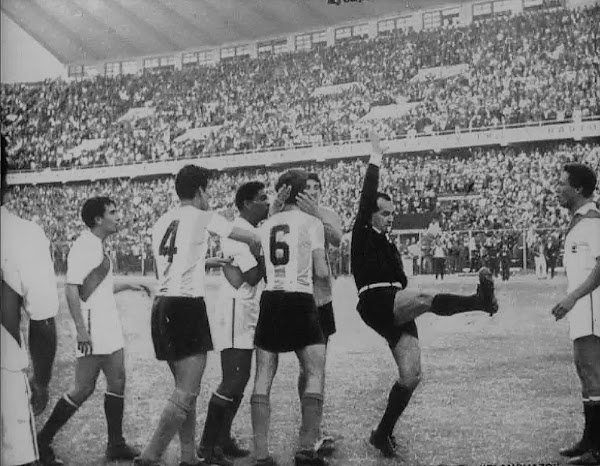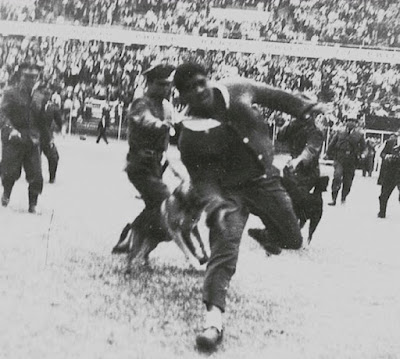“The mass is a river of screams and panic. Unstoppable and unknowing it crushes anyone who stumbles and falls. The avalanche of people goes from fear to hysteria when at the foot of the stairs, that descent into death, it encounters closed doors. Metal objects that only open to the inside. There is no turning back, away from that fatal escape route. No way back up to the stands, where, despite the asphyxiating gas, freedom awaits, instead of this prison of bodies that crush, suffocate, and kill each other. The pressure of those joining the human waterfall makes escaping impossible. The air gets exhausted. Lungs shrink. Ribs break.”
Thus, loosely translated, wrote the journalist Mauricio Gil in the Peruvian paper El Comercio. What is being described above is not the Hillsborough disaster or the Heysel drama, but by far the greatest football disaster in history. A disaster that has been almost completely forgotten outside of Peru.
 |
| Peru's team prior to the match |
On Sunday, May 24, 1964, Peru and Argentina played a qualifier for the Tokyo Olympics in Lima. Although, because of the ban on professional athletes at the Games, it was youth teams that faced off against each other that afternoon, 47,157 spectators had gathered at the Estadio Nacional according to official figures. Some sources have attendance as high as 53,000 fans. While the Argentines had won all four of their qualifiers so far, Peru had won twice and drawn once. They found themselves engaged in a tight battle for the second qualifying spot with Brazil, who were also on five points from three games. So while it wasn't the case that a loss was tantamount to elimination for Peru, with an away game in Brazil still to come, they probably did need to take at least a point.
So when the Uruguayan referee, Ángel Eduardo Pazos, disallowed a goal by Peru because of dangerous play ten minutes before the end of the game, while Argentina were leading 0-1, tempers flared. It has to be said, the grainy footage of the match doesn't really show any obvious dangerous play. The Peruvian players surrounded Pazos and protested angrily, while in the stands some clashes between Peruvian and Argentinian fans occurred. Empty bottles of beer and soda were thrown onto the field.
 |
| Referee Ángel Pazos signals dangerous play |
Eventually, things calmed down enough for the game to resume. Victor Melasio Vásquez Campos was not prepared to leave it at that. The 29-year-old Vásquez was a vague figure. His family made a living guarding a sports facility belonging to the Peruvian Air Force. He himself was supposedly a bricklayer. No stranger to the law for involvement in jewelry theft and prostitution, he had somehow managed to earn the ominous nickname 'Negro Bomba'. Vásquez had arrived early that day to drink some beers in the stadium bar, and had been back in there during half time. Drunk and enraged, he took it upon himself to call the referee to order. Worming his way through a hole in the fence, he stormed onto the field. The stadium applauded him.
Vásquez got dangerously close to the referee, before a police dog caught him, and the Guardia Civil bludgeoned him to the ground with rubber batons. A second Peruvian fan, who had followed Vásquez onto the field with a broken bottle in his hand, underwent the same treatment. The beatings reignited the anger in the stands. Fans now started throwing all sorts of things onto the field, bottles, but also broken off pieces of wood, concrete and cement. Fires were also started. The referee officially stopped the match, gesturing to the players' tunnel with both hands.
 |
| Victor Melasio Vásquez Campos storms onto the field |
Meanwhile, more people were threatening to enter the field from the north stand. Guardia Civil commander Jorge Azambuja decided to have tear gas cannisters fired into the stands. The consequences were disastrous. In the panic that ensued, 328 people were killed and another 500 were injured. Closed gates were the culprit. According to some sources, guards had locked the gates and had gone inside to watch the game themselves. According to others, the gates were closed because, due to fake tickets, thousands of angry extra spectators were present outside the stadium. Yet another source holds that some of the gates were closed during every game held at the venue, without it ever having caused a problem. In any case, hundreds of fans were crushed to death or trampled by the crowd which, in order to escape the asphyxiation caused by the tear gas cannisters, was desperate to flee the stands.
 |
| Fans try to escape the tear gas |
The scale of the disaster slowly became known over the radio. First reports had three people dead, then 10, then 60 and then 100. Meanwhile, in the streets around the stadium, the unrest blossomed into a full blown riot. While hundreds lay dead or dying in the catacombs of the stadium, looting, arson and destruction were the order of the day outside. It made it even more difficult for ambulances to come to the aid of the victims, when the city wasn't properly prepared to deal with a disaster of this magnitude in the first place.
The riots quickly spread to other parts of Lima. Shops, cars and even a Goodyear tire factory were destroyed. To illustrate how violent the unrest was: three police officers would be killed during the course of the riots. The unrest eventually led the government to declare a 30-day state of emergency, in addition to announcing seven days of national mourning.
 |
| Vehicles set on fire during the riots |
In search of a culprit for the tragedy, a 40-strong police force descended on the neighborhood where Vásquez lived two days later. "They knocked on the door of my house," the 'Negro Bomba' later declared. "When I asked who was there, someone said he was looking for Victor. As soon as I opened the door, six men stormed in, including through the roof. The whole neighborhood was surrounded." In the end, he could not be charged with much more than disturbing the peace. Vásquez would spend the rest of his life in regular contact with the police. Drugs and alcohol marred his existence. He made a living as the manager of a brothel called "la Nené", and died in 1999.
For some, Vásquez was just a scapegoat. They blamed the security forces and their overly aggressive response to the pitch invasion and the unrest in the stands. There were conspiracy theories too. For example, the idea that there were many more deaths that day than the official figures indicate, and that some of them had bullet wounds. Or that communist agitators were behind the riots. That last theory even dominated the first official report into the disaster. Not wanting to increase political tensions, the government quickly had it shelved and commissioned a second report. That one blamed Guardia Civil commander Azambuja, who eventually ended up in jail for his actions on that fateful day.
 |
| Victims in Lima's morgue |
Referee Pazos spent his whole life haunted by the trauma of the disaster. In an interview years later, he declared: "If I had known what was going to happen, I would never have disallowed that goal."
Oh, and the Olympics? Although the match had not actually been finished, Argentina was awarded the victory. With that, the Argentines qualified for the Tokyo Olympic Games. Instead of playing out the remainder of the qualifying round in its entirety, the second South American qualification ticket was awarded through a deciding match between the two remaining contenders: Peru and Brazil. What hopes the Peruvians might have had to provide the victims and their next of kin with some sort of on-field consolation, where unceremoniously dashed. They lost the match 4-0.
 |